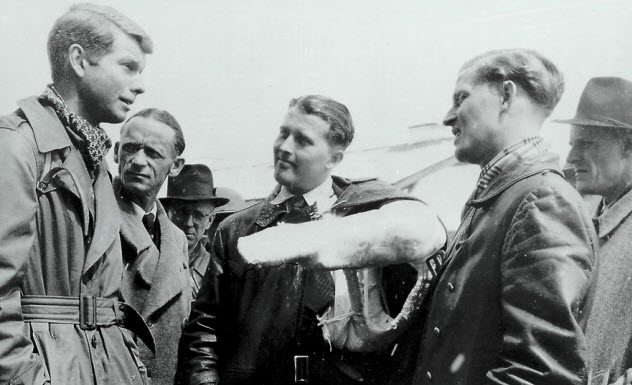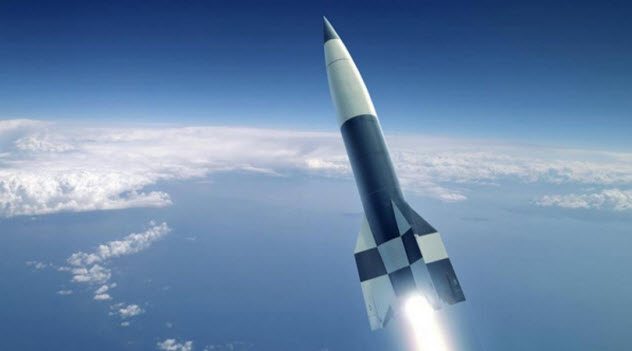 Movies and TV
Movies and TV  Movies and TV
Movies and TV  Health
Health 10 Miraculous Advances Toward Curing Incurable Diseases
 Miscellaneous
Miscellaneous 10 Undeniable Signs That People’s Views of Mushrooms Are Changing
 Animals
Animals 10 Strange Attempts to Smuggle Animals
 Travel
Travel 10 Natural Rock Formations That Will Make You Do a Double Take
 Movies and TV
Movies and TV 10 Actors Hidden in Your Favorite Movies
 Our World
Our World 10 Science Facts That Will Change How You Look at the World
 Pop Culture
Pop Culture 10 Incredible Female Comic Book Artists
 Crime
Crime 10 Terrifying Serial Killers from Centuries Ago
 Technology
Technology 10 Hilariously Over-Engineered Solutions to Simple Problems
 Movies and TV
Movies and TV 10 Movie Adaptions That Brought Popular Songs to Life
 Health
Health 10 Miraculous Advances Toward Curing Incurable Diseases
 Miscellaneous
Miscellaneous 10 Undeniable Signs That People’s Views of Mushrooms Are Changing
Who's Behind Listverse?

Jamie Frater
Head Editor
Jamie founded Listverse due to an insatiable desire to share fascinating, obscure, and bizarre facts. He has been a guest speaker on numerous national radio and television stations and is a five time published author.
More About Us Animals
Animals 10 Strange Attempts to Smuggle Animals
 Travel
Travel 10 Natural Rock Formations That Will Make You Do a Double Take
 Movies and TV
Movies and TV 10 Actors Hidden in Your Favorite Movies
 Our World
Our World 10 Science Facts That Will Change How You Look at the World
 Pop Culture
Pop Culture 10 Incredible Female Comic Book Artists
 Crime
Crime 10 Terrifying Serial Killers from Centuries Ago
 Technology
Technology 10 Hilariously Over-Engineered Solutions to Simple Problems
10 Nazi Scientists Who Survived The War
In the lead-up to World War II, it was well understood that the Third Reich was the most formidable force of science and technology that the world had ever seen. Blending occult lore and magic with cutting-edge engineering and physics, Adolf Hitler sought to master matter and spirit in much the same way as he sought to master the nations of the world.
So formidable did Hitler’s scientific might seem that many American business interests desired to ally with Nazi Germany rather than resist this growing global superpower. Chagrined with President Franklin D. Roosevelt’s socialist New Deal, prominent American businessmen even attempted to enlist the aid of decorated war hero Major General Smedley Butler in their plot to replace Roosevelt’s administration with a fascist American government.
As Nazi Germany grew in territory and influence, Hitler became increasingly envious of American manufacturing power. He dreamed of an unstoppable union of German occult science and American brute force that would solidify the Third Reich’s stranglehold over the planet’s future. Though history remembers Hitler as having lost World War II, his unholy fantasy was destined to come to fruition.
Unfazed by the war crimes perpetrated by the Third Reich during the war, leaders of the American military and industrial sectors imported dozens of top Nazi scientists to work in America after the victory of the Allies in World War II. Called Operation Paperclip, this secret initiative led to numerous medical and engineering breakthroughs, including the development of the Saturn V rocket and the founding of NASA.
In many ways, the Operation Paperclip scientists were directly responsible for the unquestioned military and economic supremacy enjoyed by America in the postwar years, yet their Nazi past was generally overlooked or whitewashed by the American media. In the following list, we’ll tell the stories of 10 Nazi scientists who survived the war and flourished as American assets.
10 Walter Schieber

Walter Schieber was a critical player in the Third Reich’s wartime production. His prewar experience in textile manufacturing made him immensely useful to the National Socialist Party, and in 1943, Hitler awarded him with the War Merit Cross.
After the war, Schieber caught the eye of Charles Loucks, a brigadier general with the US Army Chemical Corps. Loucks was assigned to the German town of Heidelberg to work on the development of nerve agents like tabun and sarin gas. Rather than being repelled by Schieber’s past, Loucks was drawn to this Nazi war criminal for his close connections with Heinrich Himmler and his intimate knowledge of the gases used by the Third Reich during the war.[1]
Schieber worked for the Chemical Corps for 10 years and later became an asset of the CIA. Since he was useful to the American government, Schieber was never prosecuted for his war crimes. In fact, he played a pivotal role in the development of the sarin gas that has subsequently been used by the US military.
9 Hubertus Strughold

Known as the “Father of Space Medicine,” Hubertus Strughold helped the United States Air Force and NASA develop many of the principles of medical care in space that are still in practice today. For years, the Aerospace Medical Association (AsMA) gave an annual award named after Strughold to prominent contributors in the field of space medicine. But when his suspicious connections to Nazi war criminals came to light, AsMA struck Strughold’s name from the award.[2]
Throughout his long career as a respected scientist in the United States, Strughold fervently denied any knowledge of the war crimes committed by the Nazis. However, he was implicated during the Nuremberg trials as having involvement with the atrocities committed at Dachau, and he spoke in detail at a Nazi conference in 1942 about the infamous “cold” experiments.
Beloved by his colleagues and students, many found it hard to believe that Strughold had lied about his involvement in Nazi human experimentation. But the evidence suggests that Strughold’s expertise in keeping people alive in space was derived at least in part from his intimate knowledge of just how much the human body can endure under extreme stress.
8 Dr. Kurt Blome

Ostensibly, Dr. Kurt Blome was Hitler’s head of cancer research. But in reality, he was in charge of the development of Nazi biological warfare capabilities.
Blome stood trial at Nuremberg for performing euthanasia and conducting human experimentation, but he was acquitted due to the intervention of the American military. The United States government wanted to expand on Blome’s intimate knowledge of human biological weaknesses to create even deadlier nerve agents.[3]
Blome’s US Army Chemical Corps personnel file makes no mention of his involvement in human experimentation. He lived out the rest of his life in West Germany working on secret projects for the American government and remained active in the right-wing Germany Party until his death in 1969.
7 Arthur Rudolph

When Arthur Rudolph was brought into the United States in 1947 as part of Operation Paperclip, he was noted to be an “ardent Nazi,” but all mention of his war crimes was omitted from official reports. However, documents from two years later confirm that Rudolph had been designated as a war criminal by Allied officials.
In 1961, Arthur Rudolph joined fellow Nazi Wernher von Braun at NASA to design the Saturn V rocket. Without Rudolph’s rocketry genius, the Apollo project would never have come to be.
Though the American government was undoubtedly grateful for his service, the Justice Department charged Rudolph in 1984 with working thousands of slaves to death while overseeing the development of the V-2 rocket during World War II. Rather than face charges, Rudolph agreed to turn in his American citizenry and leave the country.[4]
When it comes to American aerospace programs in the postwar era, it seems like asking for a history without Nazi influence is a bridge too far. We must simply content ourselves with our gratitude that NASA elected to avoid using slave labor as an expediency when paving the way to the 1969 Moon landing.
6 Magnus von Braun

Though admittedly less famous than his brother Wernher, Magnus von Braun certainly enjoyed a degree of infamy among members of the American military. They labeled him as a “dangerous German Nazi” who posed a greater threat to national security than “half a dozen discredited SS generals.” Serving as his brother’s personal assistant, Magnus negotiated the surrender of the German assembled rocket team in 1945.
After proving himself just as capable as his brother when it came to engineering, Magnus was welcomed by the US Army personnel at Fort Bliss, Texas, with a mixture of pragmatic enthusiasm and wary skepticism. Their qualms about the younger von Braun were quickly proven to be justified when Magnus was caught attempting to sell a brick of platinum that he’d stolen from the base to a jeweler in El Paso.
The incident was hushed up to avoid garnering any negative press directed at Operation Paperclip. Wernher von Braun meted out justice for the infraction personally by inflicting a brutal beating on his brother. His reputation seemingly untarnished by the incident, Magnus went on to enjoy a long and prosperous career with Chrysler before retiring to the Arizona desert.[5]
5 Dieter Grau

As a member of the von Braun rocket group, Dieter Grau was an integral player in the development of the V-2 rocket during World War II. After the war, Grau was sent to the United States as part of Operation Paperclip. He served as quality director on a number of rocket projects spearheaded by Wernher von Braun on behalf of the US government, including the development of the Saturn V rocket.
Before his work for the US Army and NASA, Dieter Grau performed quality control of a somewhat different kind. During his time as a Nazi asset in Germany, Grau was briefly posted in Mittelwerk, the underground slave labor rocket factory run by Arthur Rudolph.
At Mittelwerk, Grau employed his expertise in “debugging,” or the detection of worker sabotage. The slaves that he outed at Mittelwerk were subjected to a special punishment reserved for saboteurs: public hanging in the factory’s main hall by a crane that was raised slowly to extend the anguish.[6]
Grau lived to be 101 and was fondly remembered by his American colleagues for his attention to detail in everything that he did.
4 Walter Dornberger

Unlike other Operation Paperclip Nazi assets who got away with their war crimes scot-free, Walter Dornberger saw prison time for the use of slave labor in the production of V-2 rockets. But Dornberger, who had reached the rank of lieutenant general under Hitler’s regime, only spent two years behind bars before he was released by the American military.
He was subsequently taken to the United States to rejoin his fellow Nazi rocket scientists, and SS General Dornberger was soon elevated to the post of vice president of the Bell Aircraft Corporation.
During his career as a Nazi general, Dornberger had fired over 1,000 V-2 rockets on residential areas of London. Dornberger was also there the day that the first V-2 rocket was launched in 1937, on which occasion he asked fellow Nazi rocket scientist Wernher von Braun if he recognized the momentousness of the event that had just transpired. Von Braun responded, “Yes, today the spaceship was born.”
Dornberger believed that it was the Third Reich’s obsession with space travel that led to Hitler’s defeat. Yet when it came time to build space exploration vehicles for his new American benefactors, Dornberger was more than happy to oblige. General Dornberger lived out the rest of his life seemingly unhaunted by his past. He died in his homeland of Germany at age 84.[7]
3 Hermann Oberth

It was Hermann Oberth’s pioneering work in rocket design that originally inspired Wernher von Braun to apply himself to the study of rocketry. When Oberth first posited the idea that rockets could operate in the vacuum of space, he was ridiculed.
But when he developed the German V-2 rocket alongside von Braun, his theories took an important step toward validation. And when Oberth rejoined von Braun in America to develop the Saturn V rocket, his dreams finally took flight.[8]
While Oberth’s contributions to rocket science are undeniable, other aspects of his legacy are more open to interpretation. Potentially apocryphal quotes attributed to Oberth seem to indicate that this Nazi scientist was under the impression that human spaceflight capabilities weren’t developed by human beings alone. When asked who had assisted humanity in our quest to reach for the stars, Oberth supposedly replied, “The people of other worlds!”
Regardless of whether this quote is accurate, Oberth is on record as a firm believer that UFOs are spaceships from another solar system. Was this belief just a random supposition, or was this acclaimed Nazi aerospace scientist privy to evidence of extraterrestrial life kept outside the public sphere of knowledge?
2 Kurt Debus

Next to Wernher von Braun, Kurt Debus is the most famous former Nazi to grace the ranks of American rocketry’s hall of fame. Debus was the director of the John F. Kennedy Space Center in Florida from 1962 to 1974.
But in another life, he was Hitler’s flight test director during the development of the V-2 rocket. Despite what we know about the horrors of the V-2 development program, Debus was never held accountable for his past and he still enjoys a glowing posthumous reputation.
Debus was part of the group led by Magnus von Braun that negotiated the surrender of the German rocket scientists at the end of the war. Almost immediately, Debus was whisked away to begin work at Fort Bliss. He was soon transferred to Huntsville, Alabama, to oversee the construction of the NASA facilities at Cape Canaveral.[9]
With Debus at the helm, NASA successfully launched 13 Saturn V rockets into space, including the rocket that carried the Apollo 11 astronauts to the Moon. Yet Debus would never have been able to make these great American achievements possible had it not been for his involvement in forcing slaves to build rockets of war for the Nazi empire.
1 Wernher von Braun

Wernher von Braun was quickly recognized by Nazi authorities as being a physics and engineering genius. But von Braun was anything but bookish in nature.
His potent charisma and visionary prowess made him the perfect candidate for organizing large-scale production operations, such as the development of the V-2 rocket. At age 25, von Braun was in charge of a team of 400 people. By the time he was 30, his team had swelled to 5,000 strong.[10]
During the war, Wernher von Braun visited the slave factory at Mittelwerk at least a dozen times. On one occasion, he toured the abysmal sleeping quarters for the forced laborers. Yet, during his tenure in the American space program, he did his best to distance himself from the atrocities committed by the Nazis by putting forth the position that there was nothing that he could have done to help.
Fully aware that hundreds of slaves were dying to bring his dreams to life, von Braun still feverishly dedicated himself day and night to the development of the V-2 rocket. Without von Braun, it’s doubtful that the Saturn V rocket would have ever seen the light of day. But because of von Braun, endless ranks of forced laborers toiled and died in the darkness.
At what awful price did America buy her incontestable supremacy in space?
Read more horrific stories about the Nazi scientists on Top 10 Horrific Nazi Human Experiments and 10 Engineers And Scientists Who Built The Nazi War Machine.








